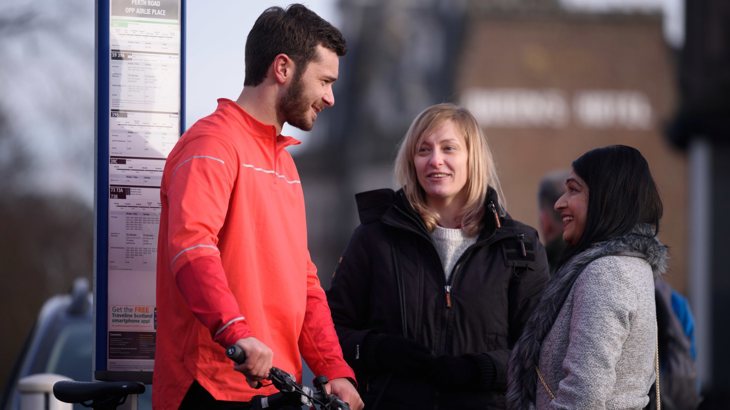A new groundbreaking study warns that young people cannot access work, education, and social opportunities due to transport barriers. The Transport to Thrive project has found that 16-24-year-olds make 21% fewer trips compared to other working age adults. This gap has widened over the past 20 years.

Availability and cost of transport are the two main barriers to travel for young people. Credit: John Linton
At the stage in life when young people should be enjoying this time to develop themselves, poor transport provision is preventing them from accessing life-defining opportunities.
The report was carried out by our team at Sustrans alongside the University of West England (UWE Bristol).
It's the first of its kind to focus on this age group who are entering adulthood.
Funded by the Health Foundation, the report presents new analyses of national travel data, combined with insights from in-depth interviews with young people leaving school and college.
Preventing further decline
The report highlights a risk of economic and social exclusion for young people without access to a car, good public transport, or cycling.
Dr Kiron Chatterjee, Professor of Travel Behaviour at UWE Bristol said:
“There has been little research on the ways that young people manage to get around using the transport system and the barriers they experience.
“This report is a crucial step in showing how young people, a key demographic for everyone’s hopes of achieving net zero, are affected by the transport system in place.
“The situation for young people is worsening and we need to see a change in transport policy that prevents further decline.
“The findings make the way forward very clear.”

The Transport to Thrive report is a crucial step in showing how young people are affected by the transport system in place. Credit: Brian Sweeney
Availability and cost of transport
Availability and cost of transport are the two main barriers to travel for young people.
Interviews revealed multiple instances where young people were unable to pursue opportunities, such as work experience or a better job, due to a lack of transport options and the inability to make journeys.
National travel data showed 16-24-year-olds without car access are 2.1 times more likely to have a low level of trip making compared to 16–24-year-olds who are the main driver of a car.
It also showed young people from households with the lowest income quintile are 1.4 times more likely to have a low level of mobility (compared to highest income quintile households).
Recommending changes
The report calls on local and national governments to better recognise the needs of young people by giving them a voice in the decisions that affect how they travel.
Other recommendations made through the report include:
- Providing long term dedicated investment for walking, cycling and public transport
- Devolving powers to local transport authorities to take greater control of buses
- Providing financial support for young people to access a cycle.
Tim Burns, Head of Policy at Sustrans, said:
“This report shows national and local transport policies are denying young people opportunities for education and work.
“This has a knock-on effect on our future economy and in our communities, which will be profoundly damaging.
“Investment will be key to removing barriers, especially those identified by young people, including improving the quality of public transport, and access to cycles and safe cycle routes.”
The report notes that young people recognise the need to be less car dependent and are more likely to use a range of transport options including public transport, walking, and cycling.
Recognising the needs of young people
Commenting on the release of the report, Jo Bibby, Director of Health at the Health Foundation, said:
“This timely report shows how that young people are being left behind by transport policy decisions.
“Experiences at this age – such as job and educational opportunities – are crucial to enable young people to thrive, both now and in the long-term.
“It is disappointing that a lack of public transport and active travel options are denying many young people opportunities to work, socialise and access public services, all of which we know are important for good health.
“It is important that national and local authorities take this opportunity to act, beginning with ensuring that the needs of young people are recognised and prioritised in transport policy making.
“This must include a prioritisation of active travel infrastructure and public transport, to support healthier lives and a healthier economy.”





